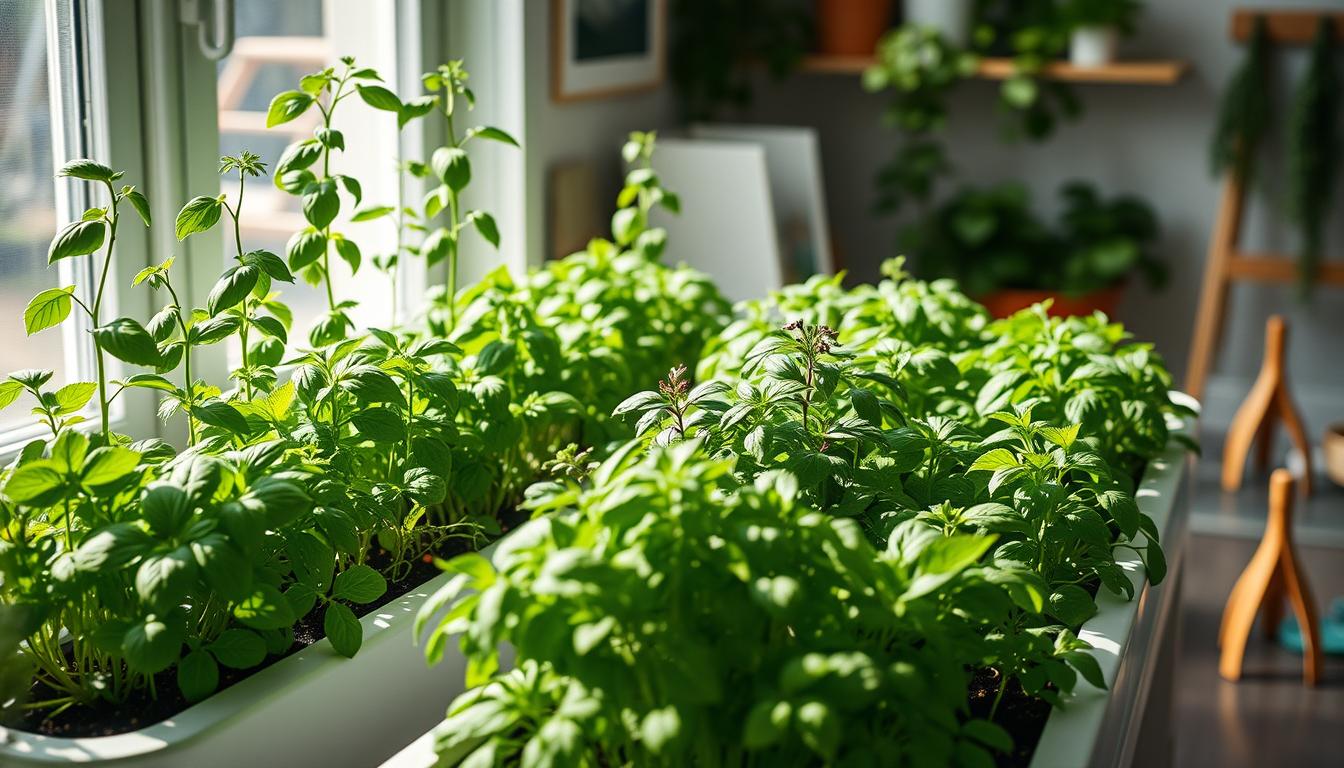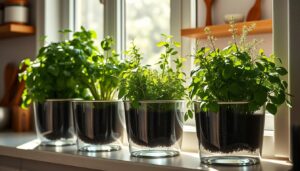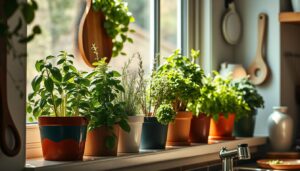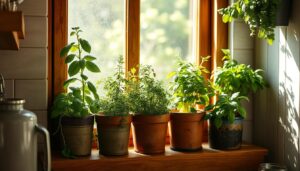Imagine having a garden full of herbs without any soil. Welcome to the world of hydroponics, where plants grow in water full of nutrients instead of soil. With hydroponic herb gardening, you can have fresh, tasty herbs all year, right in your home.
Key Takeaways
- Hydroponics is a way to grow plants in water full of nutrients, not soil. It has many benefits over traditional gardening.
- With hydroponic herb growing, plants grow faster, have fewer pests, and you can control their environment better.
- Look into different hydroponic systems and methods, like aeroponic, aquaponic, and containerized, to find what works best for your garden.
- Learn how to set up and keep a hydroponic herb garden healthy, from choosing the right gear to fixing common problems.
- Find out which herbs like basil, chives, and mint are best for indoor hydroponics and how to take care of them.
What is Hydroponics?
Hydroponics is a way of growing plants without soil. It’s a method that lets plants grow well without soil. Instead, they get their nutrients from a special water solution.
Understanding the Basics of Soilless Gardening
Hydroponics is all about getting the right balance of nutrients and water for plants. Plants grow in a nutrient-rich water solution without soil. This method has been around for a long time, dating back to the Hanging Gardens of Babylon.
It’s now popular for growing plants at home and in big farms. Hydroponics lets you control what plants get and when. This means plants grow faster and produce more than they would in soil.
“Hydroponics allows plants to absorb nutrients directly through their roots, leading to faster growth and higher yields compared to traditional soil-based cultivation.”
More people are trying soilless gardening because it’s efficient and good for the planet. Hydroponics lets you grow your own food and flowers indoors. It’s a great way to enjoy gardening without the hassle of soil.
Benefits of Growing Herbs with Hydroponics
Hydroponics is a great way to grow an indoor herb garden. It has many advantages over traditional soil gardening. You get more herbs and they taste better.
Hydroponics lets you grow herbs in a small space. It gives plants exactly what they need, right to the roots. This means your herbs grow bigger and stronger, giving you more yield from less space.
Hydroponics also means fewer diseases and pests. Without soil, you don’t have to worry about soil problems. Your herbs grow healthier and more vibrant.
Another big plus is controlling the growing conditions. You can adjust light, temperature, and pH levels. This helps your herbs grow to their best and taste better.
With hydroponics, you can grow herbs all year. You don’t have to wait for the right season. Enjoy fresh herbs anytime, no matter the weather.
In short, hydroponic herb gardening has many benefits. You get more herbs, better flavor, and they’re available all year. It’s a great way to grow your own herbs indoors.
Different Types of Hydroponic Systems
There are many ways to grow herbs indoors without soil. Each hydroponic system has its own benefits and needs. This lets gardeners pick the best one for their space and herb growing goals.
Exploring Various Techniques for Indoor Gardening
The drip system is a popular choice. It sends nutrient-rich water straight to the roots. Flood-and-drain systems soak the roots in nutrients at times. Water culture systems keep roots in a water bath with oxygen.
Aeroponics uses a fine mist to feed the roots. This method is more advanced.
| Hydroponic System | Description | Advantages |
|---|---|---|
| Drip System | Delivers nutrient-rich water directly to plant roots | Efficient water and nutrient delivery, easy to monitor and maintain |
| Flood-and-Drain | Periodically submerges roots in nutrient solution | Provides ample oxygen and nutrient access for plant growth |
| Water Culture | Roots are partially submerged in continuously oxygenated water | Simple setup, requires less maintenance than other systems |
| Aeroponics | Uses a fine mist to nourish suspended roots | Maximizes oxygen exposure for faster growth, conserves water and nutrients |
Learning about types of hydroponic systems, indoor hydroponic gardening techniques, and soilless cultivation methods helps you choose the right hydroponic system design for your herbs. Look at the good and bad of each system to find the best one for your space.
Grow herbs indoors without soil
Growing herbs indoors without soil is a big step for garden lovers. Hydroponic gardening lets you make a lush indoor herb garden, even in tiny spaces. You suspend plant roots in a water solution full of nutrients. This way, your herbs get everything they need to grow well without soil.
Soilless herb growing has many perks for home gardeners. Say goodbye to weeds and pests, and forget about constant soil upkeep. With hydroponics, you control the environment. This means your herbs get the right amount of light, water, and nutrients for best growth.
Indoor hydroponic herb gardening means fresh, tasty herbs all year, even in tough climates. If you want to add green to your kitchen or try soilless herb cultivation, hydroponics makes it easy to grow herbs indoors without soil.
“Growing herbs hydroponically is a game-changer for urban gardeners and home cooks alike. It’s a simple, efficient way to enjoy a bountiful harvest, right at your fingertips.”
With the right setup and care, you can have a thriving indoor hydroponic herb garden. It will give you fresh, fragrant herbs all year. It’s ideal for those who want to grow herbs indoors without soil and enjoy gardening at home.
Popular Herbs for Indoor Hydroponic Gardening
Start your journey to grow a thriving indoor herb garden with hydroponics. Whether you’re experienced or new to gardening, indoor herb varieties for hydroponics offer many options. From aromatic basil to versatile mint, the best herbs for indoor hydroponic growing can make your kitchen smell like a garden.
Basil is a top choice for hydroponic gardens, loved for its sweet flavor and easy growth indoors. Mint is another top pick, adding a refreshing touch to dishes. Parsley is great for hydroponics too, offering a burst of flavor and nutrients.
Other popular herbs include chives, thyme, rosemary, and oregano. These herbs add flavor to meals and beauty to your home. For a wider selection, try cilantro, sage, tarragon, and lavender in your hydroponic garden if they fit your growing conditions.
When picking hydroponic herbs, think about the space you have. Choose compact varieties that won’t get too big. With the right care, you can enjoy a lot of best herbs for indoor hydroponic growing. This will make your kitchen a place of culinary joy and health.
Starting your hydroponic herb garden is exciting. Remember, these plants are versatile and easy to care for. With some knowledge and the right methods, you can grow a beautiful indoor herb garden. This will improve your cooking and add nature to your home.
Setting Up Your Hydroponic Herb Garden
Starting a hydroponic herb garden at home is rewarding and lets you grow fresh herbs all year. First, you need to get the right equipment and materials for your indoor hydroponic setup.
Essential Equipment and Materials
For a successful hydroponic herb garden, you’ll need:
- A growing container like a plastic tote, aquarium, or custom planter
- An air pump and airstone for the right amount of oxygen in the water
- A pH testing kit to keep the water at the best pH for your herbs
- Hydroponic nutrients to give your herbs the minerals and nutrients they need
- Net pots or other growing media to hold and support your herb plants
You can make a DIY hydroponic system with items like PVC pipes, old bottles, or plastic containers. The main thing is to make sure your system has good water flow, air, and nutrient delivery. This way, your herbs will grow well without soil.
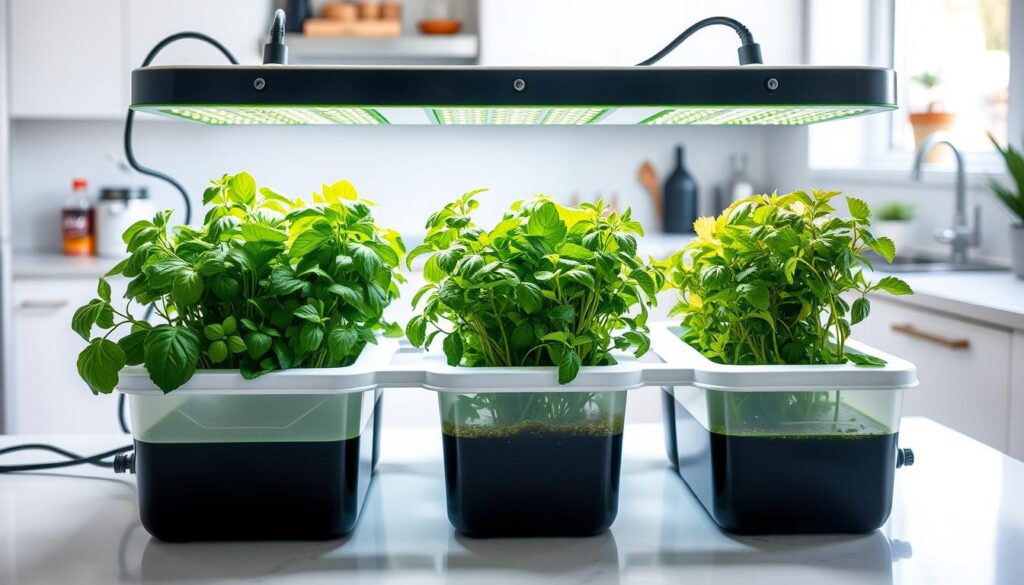
With the right setup, you can have a self-sufficient, indoor hydroponic herb garden. This lets you enjoy a lot of fresh, tasty herbs all year.
Maintaining Your Hydroponic Herb Garden
Keeping your indoor hydroponic herb garden healthy and productive needs regular care. To keep your herbs thriving, learn the key steps for maintaining a hydroponic herb garden. This includes checking nutrient levels and controlling the environment.
Checking and adjusting the pH and nutrient levels in the water is vital. Herbs need the right balance of nutrients and acidity. Keeping an eye on these and adjusting them helps with growth and flavor.
Good aeration is also key for troubleshooting a hydroponic herb system. It prevents stagnation and root rot, which harm plants. Make sure the water pumps and air stones work well to keep roots oxygenated.
Keeping your hydroponic setup clean is crucial. Clean the grow tray, reservoirs, and other parts often. This stops algae and contaminants that slow plant growth. Regular cleaning keeps your garden healthy.
Watch and adjust the lighting, temperature, and humidity for your herbs. Each herb has its own needs. Adjust these conditions to give your plants the best environment for growth and flavor.
Follow these tips for how to maintain a hydroponic herb garden. With consistent care, your indoor herb garden will flourish. You’ll get a lot of tasty, nutrient-rich herbs for your cooking.
Troubleshooting Common Issues
Keeping a hydroponic herb garden healthy needs careful watching and quick thinking. You might face issues like nutrient shortages, pH problems, root rot, or pests. Knowing how to spot these problems is key to keeping your indoor herb garden strong and full of life.
Solving Problems and Addressing Concerns
Nutrient imbalances are a big challenge in hydroponic gardens. If your plants look yellow, grow slow, or change color, it’s time to check the nutrients. Make sure the pH levels are right to give your herbs what they need.
Root rot is another big problem, caused by bad water flow or not enough oxygen. If roots turn brown or soft, fix it fast. Clean the system, improve water movement, and add good bacteria to stop and fix root rot.
Algae can also be a big issue in indoor gardens. It takes nutrients from your herbs and messes with the system’s balance. Clean regularly and use UV sterilizers or other methods to stop algae.
Pests and diseases are less common indoors but can still happen. Watch your plants closely and use safe pest control, like good insects or natural sprays, to keep them away.
Knowing about these common problems and fixing them fast will help your hydroponic herb garden do well. This way, you’ll always have fresh, tasty herbs for cooking.
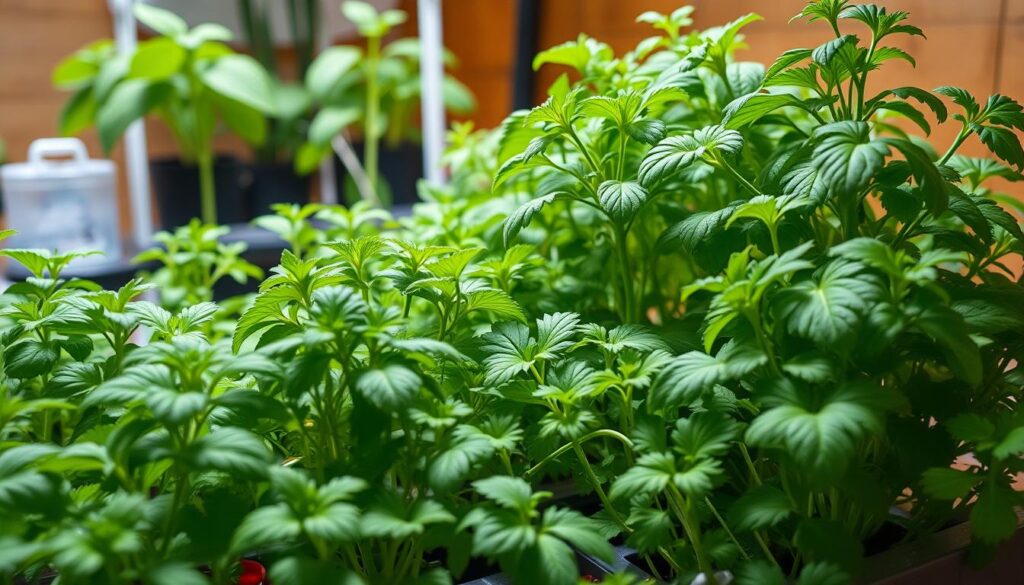
Harvesting Your Hydroponic Herbs
Growing herbs in a hydroponic system lets you pick fresh, tasty leaves and stems as you need them. Most herbs are ready for harvest in 4-8 weeks after planting. This means you can have a steady supply of fresh herbs all year.
To pick your hydroponic herbs, just cut off the leaves you want, leaving 2-3 inches of stem. This helps the plant keep growing and lets you harvest more later. Cutting just right, like above a leaf node, makes your plants bushier and more productive.
With a healthy indoor hydroponic herb garden, you can have fresh harvesting herbs from a hydroponic system all year. Here are some tips on when to harvest hydroponic herbs and tips for harvesting indoor hydroponically grown herbs for a great harvest.
- Harvest herbs in the morning when they are at their best.
- Use sharp, clean scissors or pruners to cut just above a leaf node.
- Don’t take more than one-third of the plant at once to keep it healthy.
- Keep harvested herbs fresh in the fridge or preserve them for later.
| Herb | Typical Harvest Time | Recommended Harvesting Method |
|---|---|---|
| Basil | 4-6 weeks | Snip leaves or stems above a leaf node |
| Mint | 6-8 weeks | Cut stems 2-3 inches above the soil |
| Thyme | 8-10 weeks | Trim stem tips, leaving at least 2 inches of growth |
“With a thriving hydroponic herb garden, you can enjoy a steady supply of fresh herbs for your cooking throughout the year.”
Conclusion
Growing herbs indoors with hydroponics has many benefits for home gardeners. It lets you have fresh herbs all year without the hassle of soil and pests. By learning the basics of soilless gardening and picking the right hydroponic setup, you can create a garden that gives you tasty, healthy herbs anytime.
The advantages of indoor hydroponic herb gardening include growing herbs all year, reducing pests and diseases, and getting a lot of fresh, fragrant herbs. With proper care, hydroponic herb growing is easy and rewarding for any home. It’s great for both experienced gardeners and beginners who want to grow their favorite herbs at home.
By using the tips for successful hydroponic herb cultivation from this article, you can make the most of indoor gardening. With some knowledge and effort, you can easily enjoy the benefits of soilless gardening. This way, you can have the fresh, tasty herbs you love right at your fingertips.
FAQ
What is hydroponics?
What are the benefits of growing herbs with hydroponics?
What are the different types of hydroponic systems?
What herbs can be grown indoors without soil using hydroponics?
What equipment and materials are needed to set up a hydroponic herb garden?
How do I maintain a hydroponic herb garden?
What are some common issues with hydroponic herb gardening and how can they be addressed?
When and how should I harvest my hydroponic herbs?
Source Links
- Hydroponic Herb Garden Guide – https://www.epicgardening.com/hydroponic-herb-garden-guide/
- DIY Hydroponics 101: All You Need to Know About Growing Plants Without Soil – https://www.bobvila.com/articles/diy-hydroponics/
- How to grow delicious food inside without using any soil – https://medium.com/indoor-hydroponics/growing-food-inside-without-soil-e21411f40aed


